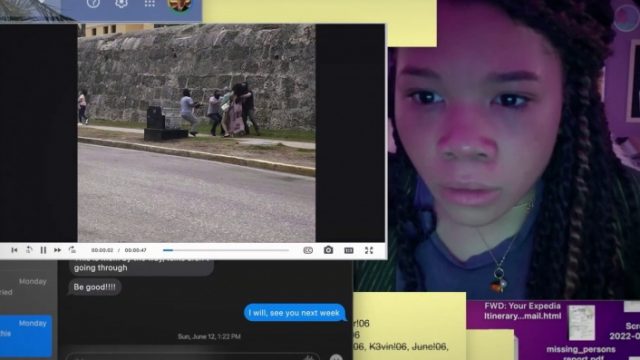In late Summer of 2018 the slight but well-received mystery Searching had a father searc looking for his disappeared daughter with clues left behind on her laptop. This past week’s new release Missing follows up on that film but pulls a switcheroo by having a daughter June (Storm Reid) desperately seeking clues to find her mother after she goes missi somewhere unknown.
June’s mother Grace (Nia Long) is one of those silly adults who asks Siri to do everything, makes video calls without meaning to, and insists on leaving voicemails. June still grieves her long dead father and plans some rebellious teenage partying as soon as her mother leaves on a Columbian vacation with new boyfriend Kevin (Ken Leung). But when Mom and Kevin are no-shows at LAX a week later, June has to log on and follow their swerving digital trails before they go cold. Circumstances aren’t what they seem, and to piece together Grace’s whereabouts June must also fill in some blanks spots in her mother’s life.
It’s a spiritual sequel to Searching – the events of that film are winked at in an amusing parody of a Netflix true crime series called Unfiction – that uses its central conceit of playing out the movie’s action on June’s laptop screen. This requires some flexibility with logic – the device’s camera is open to selfie-mode as a default – but like its progenitor, Missing isn’t as concerned with the rigor of the gimmick to the degree of the browser-based gold standard Unfriended. New directors Nicholas D. Johnson and Will Merrick, working from an “air tight” outline by Searching‘s creators Aneesh Chaganty and Sev Ohanian (who also made the Solute-recommended Run in between), zoom from window to app to cursor prompt and follow conversations, monetary transactions, and memories replayed (or altered) in video programs. Pacing stays paramount while the mystery unfolds.
John and Merrick were the editors of Searching, and the style and substance have enough similarities that it’s interesting to track what’s different after five years of online life. We’ve grown accustomed to greater clarity in our consumer-grade cameras, for one thing, and their ubiquity has only spread. Missing now can include Ring doorbells and vehicle backup cameras and TikTok videos to its repertoire of texts, FaceTimes, and Instagram posts (facebook itself is completely absent for the 2023 version, anybody check if it left its Location Services on?) The movie also has an altered, or likely just amplified, zeitgeist to work within, from the gig economy to conspiracy rabbit holes (not to mention a solid Captcha joke). Like any good mystery, clues and red herrings appear with frequency and getting ahead of them evokes appreciation for their clever deployment.
Among all its motion graphic gimmickry and story twists the original Searching managed a solid parallel dramatic conceit where a father gradually learns how little he knows about his daughter. Missing follows similar thinking, though watching a sullen teenager discover she maybe likes her mom more than she lets on doesn’t have much dramatic heft beyond giving a spine to a story. This is no fault of the performers – Reid is never less than pitch perfect, though acting a thriller for a laptop camera must feel like dancing in a closet.
In the race to its final resolution, the film serves the mystery over these performances. The twists keep the thrills coming, but undermine some of the more meaningful character development. Still, the rewards for keeping your eyes peeled and your puzzle senses sharp make this a worthwhile spin. If Chaganty and Ohanian want to load up another dense screen mystery in a few years (Buffering?), there’s more room on the desktop.
Missing is currently playing in theaters, though will no doubt be available for your laptop in the near future.

